This guide focuses on swine nutrition, a crucial aspect for pig owners. It covers understanding nutritional requirements, optimizing feed formulation, and managing environmental factors. This knowledge is vital for maintaining swine herd health, growth, reproduction, and productivity and optimizing feed formulation and environmental factors.
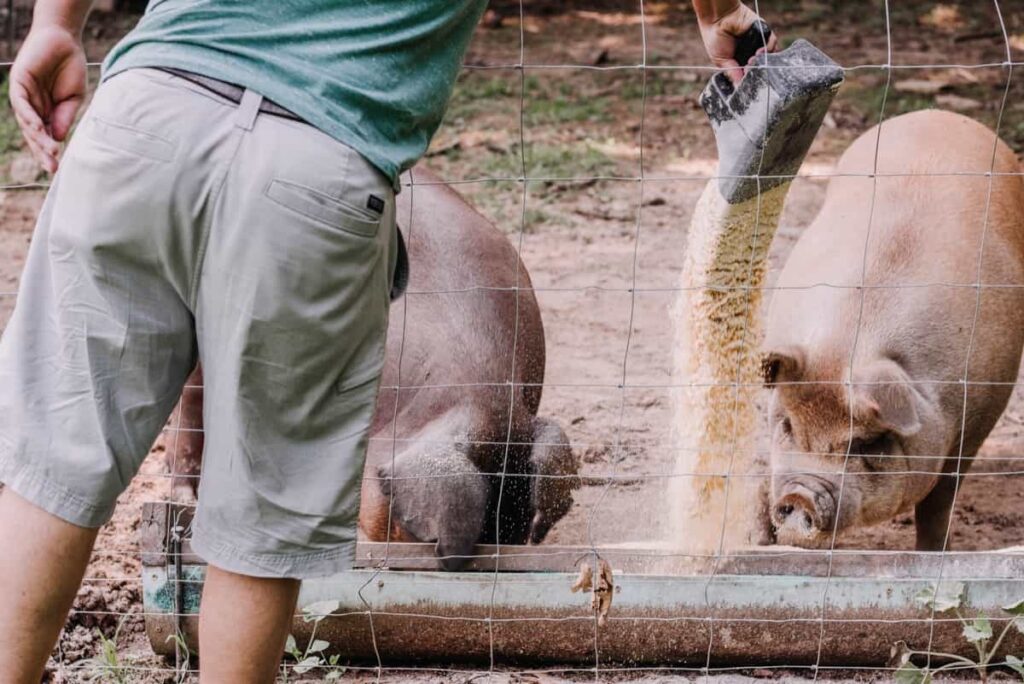
Mastering Swine Nutrition
Understanding the Nutritional Requirements of Swine
To achieve proficiency in swine nutrition, it is important to comprehensively comprehend the distinct nutritional requirements of pigs during various developmental phases. The dietary needs of swine exhibit variations throughout many stages, including gestation, lactation, and growth phases. Protein, energy, vitamins, and minerals are of utmost importance in swine health, and it is crucial to customize diets to fulfill these requirements to achieve the best outcomes.
For example, gestating sows need meals with elevated energy levels to sustain the growth of the developing fetuses. Still, nursing sows necessitate augmented quantities of certain nutrients to facilitate milk production. Maintaining a well-balanced diet that fulfills the nutritional requirements of swine across different life stages is crucial for promoting optimal health and enhancing the efficiency and profitability of swine farming endeavors.
The Importance of Feed Quality in Swine Nutrition
Swine requires high-quality feed containing a balanced combination of essential nutrients such as proteins, carbohydrates, lipids, vitamins, and minerals to facilitate optimal growth and development. Furthermore, it decreases the likelihood of nutrient deficiencies, which are detrimental to health and cause stunted growth. Regular testing of ingredients and finished feed is essential to ensure the nutrient content aligns with the pig’s dietary requirements at different life stages.
Quality feed directly influences feed conversion efficiency, a critical metric in swine production. Efficient feed conversion is cost-effective for farmers and indicates that the nutritional needs of the pigs are being met. Poor-quality feed can result in suboptimal feed conversion rates, increasing production costs, and potentially stunted growth. Feed quality also involves safeguarding against contaminants like mold, mycotoxins, and other harmful substances.
In case you missed it: Pig Housing Design: How to Create Comfortable and Efficient Living Spaces for Pigs
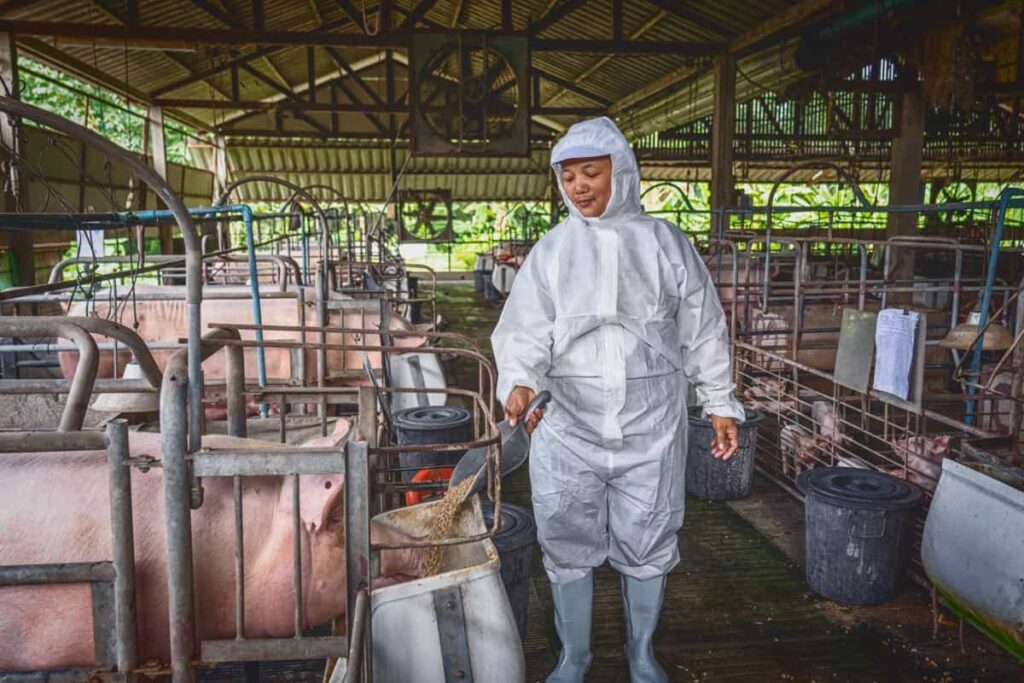
Rigorous quality control measures, including regular testing and proper storage, are essential to mitigate these risks and maintain the integrity of the feed. Feed quality also enhances reproductive performance in swine, particularly in breeding sows. High-quality feed formulated with precision ensures that sows receive the necessary nutrients, contributing to successful pregnancies, healthier piglets, and improved reproductive efficiency.
How to Balance Energy and Protein in Swine Diets
In swine nutrition, striking the correct balance between calories and protein is a delicate ballet. Pigs that are active need enough energy for both growth and maintenance, and they also need protein to build muscle. Comprehending the complexities of this equilibrium is essential for creating diets for pigs that work. For example, since specific amino acids are required to produce proteins, it is important to balance the amino acid profile in the diet.
This necessitates choosing feed items high in these amino acids with consideration. Furthermore, keeping an eye on the energy content of the food guarantees that pigs get the calories they need without gaining too much weight. Farmers may achieve higher growth rates, increased feed efficiency, and generally healthier pigs by regularly monitoring and modifying the energy-protein balance in swine diets.
Essential Vitamins and Minerals for Swine
Swine health and well-being rely on essential vitamins and minerals. These micronutrients support various physiological functions, ensuring optimal growth, reproduction, and overall performance of a herd. Vitamin A is required for pigs to have good eyesight, but vitamin D is required for calcium and phosphorus metabolism, avoiding skeletal abnormalities, and encouraging structural integrity. Vitamin E protects cells against oxidative damage, boosts the immune system, and improves general health.
Vitamin K is essential for blood clotting, preventing excessive pig bleeding, and maintaining hemostasis. B vitamins include thiamine (B1), folate (B9), and cobalamin (B12). They are very important for making energy and keeping your metabolism running smoothly. Minerals like zinc and copper contribute to immune function and enzyme activity in swine, aiding wound healing and overall health. Selenium deficiency can lead to muscle disorders and compromise the overall health of swine.
Iron is vital for hemoglobin formation, and piglets require sufficient iron for proper growth and development due to limited iron stores at birth. Calcium and phosphorus are critical for skeletal health, contributing to bone and teeth formation. Potassium and sodium are essential for maintaining electrolyte balance and crucial for various physiological functions, including nerve transmission and muscle contraction.
In case you missed it: Sheep Milk Production: Lactation Period, Uses, Benefits, Price, and Dairy Sheep Breeds
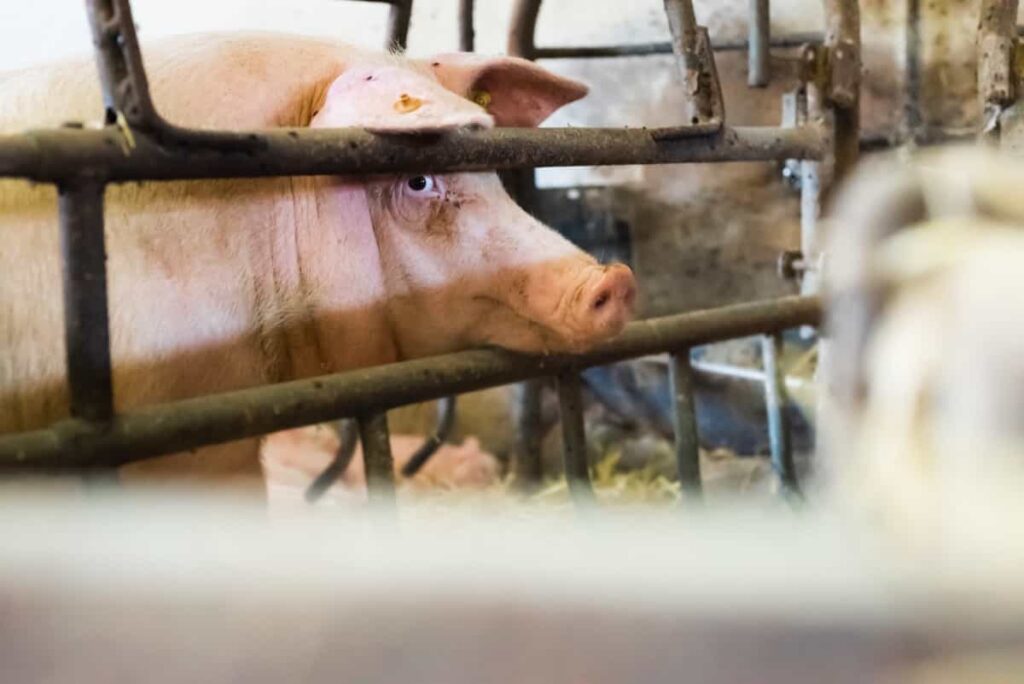
How to Evaluate Different Feed Ingredients for Swine Diets
- Nutritional Profile
- Examine the nutrient composition of each feed ingredient, including protein, energy, vitamins, and minerals.
- Ensure that the nutritional content aligns with the specific dietary requirements of swine at different life stages.
- Amino Acid Composition
- Assess the amino acid profile of protein sources.
- Opt for ingredients that provide a well-balanced array of essential amino acids crucial for swine growth and development.
- Energy Density
- Consider feed ingredients’ energy content to meet active pigs’ energy requirements.
- Balance energy sources to prevent excessive weight gain or inadequate growth.
- Anti-Nutritional Factors
- Identify and evaluate potential anti-nutritional factors in ingredients, such as enzyme inhibitors or toxic compounds.
- Mitigate risks by processing or combining ingredients to minimize negative effects.
- Palatability
- Evaluate the palatability of feed ingredients to ensure pigs readily consume the formulated diets.
- Experiment with ingredient combinations to enhance overall feed intake.
- Digestibility
- Assess the digestibility of feed ingredients, particularly in terms of fiber content.
- Choose ingredients that promote optimal digestion and nutrient absorption.
- Availability and Cost
- Consider the availability and cost-effectiveness of feed ingredients.
- Explore locally sourced options to minimize transportation costs and support sustainability.
The Role of Fiber in Swine Nutrition
Regarding swine nutrition, fiber is sometimes overlooked, although its significance cannot be emphasized. Comprehending the function of fiber is essential for developing a well-rounded diet for pigs since it facilitates digestion and enhances gut health. In the pig’s digestive tract, dietary fiber from things like soybean hulls and wheat bran helps foster the growth of a balanced microbial population.
In case you missed it: Sheep Milk Production: Lactation Period, Uses, Benefits, Price, and Dairy Sheep Breeds
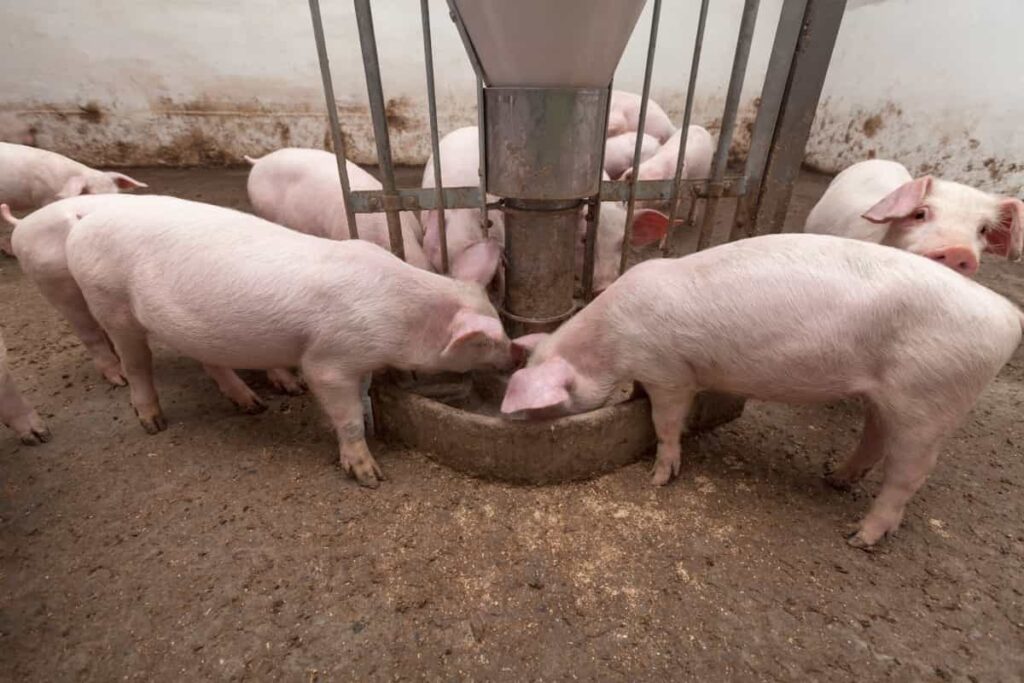
This improves the absorption of nutrients and supports intestinal health in general. Additionally, fiber gives the diet volume, which is crucial for sow diets to maintain appropriate gastrointestinal motility during pregnancy. Farmers may improve the health of their pigs’ digestive systems, lower their risk of digestive problems, and maximize nutrient absorption by including the right kinds of fiber in their meals.
How to Manage Feed Additives in Swine Diets
- Identify Nutritional Gaps
- Assess the nutritional needs of swine at different life stages.
- Identify specific deficiencies or challenges that feed additives can address, such as enhanced growth, immune support, or improved digestion.
- Understand Additive Types
- Familiarize yourself with different feed additives, including probiotics, prebiotics, enzymes, organic acids, and antimicrobials.
- Understand the specific functions and benefits each type provides in swine nutrition.
- Consult with Nutritionists
- Collaborate with swine nutritionists to determine the most effective feed additives for your herd and production goals.
- Leverage their expertise to create a targeted additive strategy.
- Precision in Dosage
- Ensure precise dosage of feed additives according to recommended levels.
- Avoid overuse, as excessive amounts may lead to unintended consequences or reduced cost-effectiveness.
- Consistent Mixing
- Implement thorough and consistent mixing of feed additives with the complete diet.
- Distribute additives evenly to ensure each pig receives the intended nutritional benefits.
- Monitoring and Adjustments
- Regularly monitor the performance of swine in response to feed additives.
- Be prepared to adjust dosage or formulation based on observed results and any changes in herd health or production objectives.
- Quality of Additives
- Source feed additives from reputable suppliers to ensure quality and efficacy.
- Regularly check for certifications and conduct quality control tests on additive batches.
Water Quality and Hydration in Swine Nutrition
While much attention is given to feed, water quality is equally vital. Ensuring clean water and proper hydration is essential for digestion, nutrient absorption, and overall swine well-being. This section provides insights into maintaining optimal water conditions on your farm. Contaminated or inadequate water can lead to various health issues, including dehydration and decreased feed intake.
In case you missed it: Dairy Farm Operations Management: Month-Wise Maintenance for Better Profits
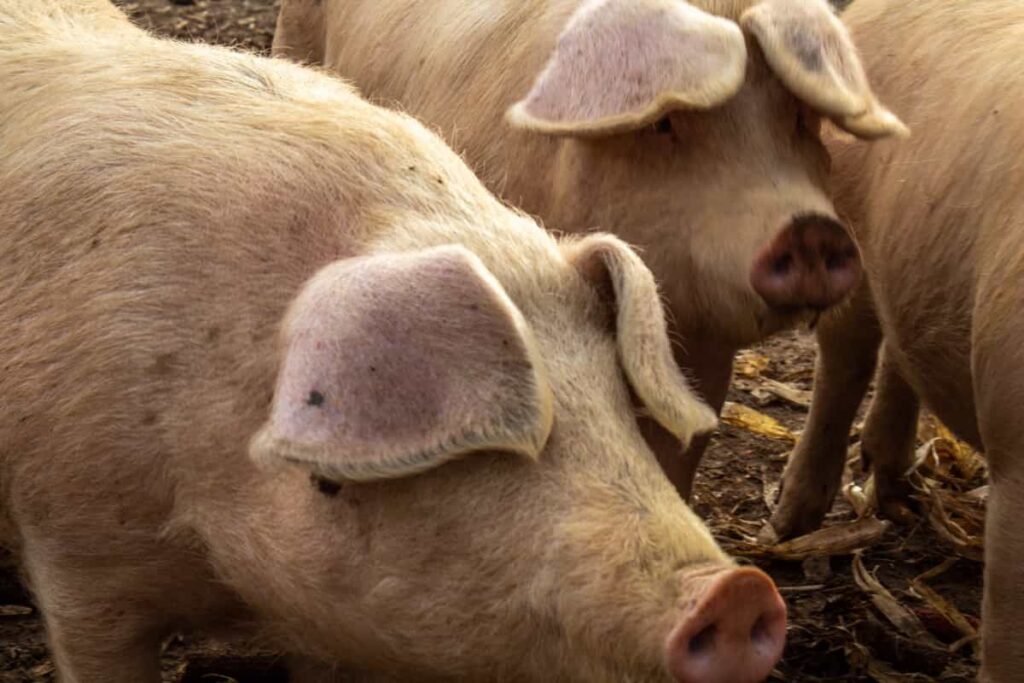
Regular water quality testing, proper water source management, and adequate water supply are critical components of swine nutrition. By prioritizing water quality and hydration, farmers contribute to their swine herd’s overall health and performance, ensuring optimal growth and productivity.
Feeding Strategies for Sows During Gestation and Lactation
Sows play a pivotal role in the swine production cycle. Tailoring feeding strategies to meet the unique nutritional needs of gestating and lactating sows is critical for successful reproduction and healthy piglets. During gestation, providing a balanced diet that meets the sow’s nutritional requirements without excess weight gain is essential.
Adjusting the diet during lactation to support milk production and the nutritional demands of nursing piglets is equally crucial. By implementing targeted feeding strategies for sows, farmers can optimize reproductive performance, improve piglet health, and enhance the long-term productivity of the swine herd.
Transitioning Piglets to Solid Feed
- Start Early
- Begin introducing solid feed to piglets early in their life, typically around three weeks of age.
- Gradual exposure allows piglets to adapt to the new diet without causing stress or disruptions.
- Palatable Starter Diets
- Offer highly palatable starter diets that entice piglets to explore and consume solid feed.
- Starter diets should be nutritionally balanced to support growth and development during this critical stage.
- Provide a Feeding Trough
- Introduce feeding troughs that allow easy access to the solid feed.
- Troughs should be low enough for piglets to reach comfortably and designed to minimize feed waste.
- Mimic Sow’s Diet
- Formulate starter diets to mimic the nutritional composition of the sow’s milk.
- This similarity in flavor and nutrients encourages piglets to accept the transition to solid feed.
- Gradual Transition
- Initiate the transition gradually, alongside continued access to the sow’s milk.
- Over several days or weeks, incrementally increase the proportion of solid feed while decreasing milk availability.
- Observation and Adjustment
- Regularly observe piglet behavior and monitor feed intake.
- Adjust the texture and formulation of the solid feed based on piglet response and overall health.
- Pelleted or Crumbled Feed
- Consider using pelleted or crumbled feed for piglets, as these forms are often more palatable and easier for young pigs to consume.
- Ensure that the particle size is appropriate for their age and size.
Nutritional Considerations for Growing and Finishing Pigs
The dietary needs of developing and maturing pigs vary compared to those of young piglets. This section explores the changing needs of pigs as they mature and approach market weight, providing insights into optimizing their diets for efficient growth. Growing and finishing pigs require diets with higher energy density and balanced nutrient profiles to support rapid growth and muscle development.
Fine-tuning the diet composition based on growth stage and body weight is essential for achieving optimal feed efficiency and carcass quality. Comprehending nutritional factors about pigs’ growth and final stages enables farmers to make well-informed choices, thus enhancing productivity and guaranteeing superior pork products to the market.
In case you missed it: 20 Best Pork Producing Companies in the United States: Top List for Hog and Pig Meat in the USA
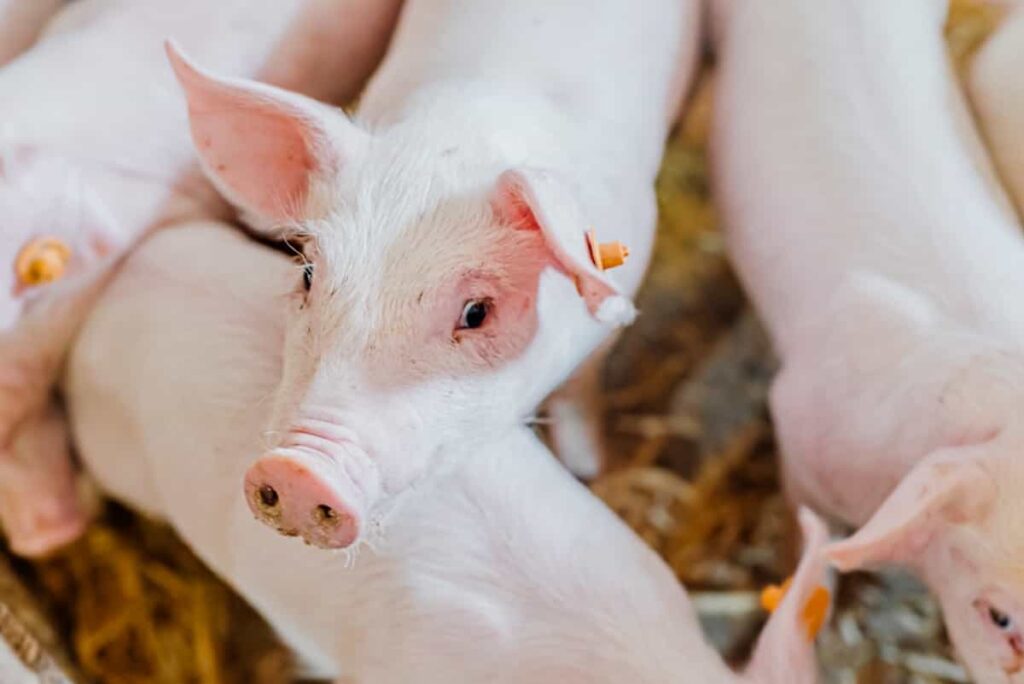
How to Optimize Feed Formulation for Swine Diets
Optimizing feed formulation is both a science and an art. This section dives into the nuances of creating well-balanced swine diets, considering factors such as cost, nutritional requirements, and the availability of feed ingredients. Feed formulation involves selecting ingredients in precise proportions to match the nutritional needs of the target swine population.
Balancing protein, energy, vitamins, and minerals while considering factors like feed palatability and digestibility is crucial for formulating diets that promote optimal growth and health. By mastering the art of feed formulation, farmers can maximize the efficiency of feed utilization, reduce production costs, and enhance the overall performance of their swine herd.
Managing Temperature, Ventilation, and Lighting That Affect Swine Nutrition
Environmental factors, including temperature, ventilation, and lighting, can significantly impact swine nutrition. Provide an optimal environment for your pigs, ensuring they thrive under various conditions. Temperature regulation is critical for swine, especially during extreme weather conditions. Maintaining proper ventilation and lighting further contributes to the well-being and comfort of the pigs.
Adequate lighting, for example, influences feeding behavior, reproductive performance, and overall herd productivity. By managing these environmental factors effectively, farmers create a conducive environment that supports swine health, minimizes stress, and maximizes productivity.
Frequently Asked Questions on Swine Nutrition
How Does Sustainable Pig Farming Contribute To Environmental Conservation?
Sustainable pig farming minimizes environmental impact by optimizing resource use, reducing waste, and adopting eco-friendly practices. It focuses on ethical and responsible production methods to ensure long-term environmental conservation.
What Role Do Alternative Proteins Play In Pig Diets, And Are They A Sustainable Option?
Alternative proteins, such as insect meal and plant-based proteins, are being explored as sustainable options in pig diets. These proteins can reduce reliance on traditional feed sources and contribute to more environmentally friendly farming practices.
Conclusion
Gaining a thorough grasp of the nutritional requirements of pigs at every stage of development is essential to mastering the complex field of swine nutrition. Every element, from the choice of ingredients and feed quality to environmental control, is vital to maintaining the well-being and output of your pig herd. You will be well-prepared to produce healthy and thriving pigs on your farm, which will add to the profitability and sustainability of your swine farming business if you put the tactics described in this extensive book into practice.
- Profitable Village Farming Business Ideas in 2024
- High-Yield Aquaculture: Fast-Growing Fish for Farming
- Effective Fish Pond Construction Techniques for Beginners
- Irrigation and Water Management in Pineapple Farming
- Blossom to Harvest: Mastering Flowering and Pollination in Papaya Farming
- Pig Fattening Essentials: From Selection to Sale for Beginners
- Raising Wagyu Cattle: A Complete Guide for Premium Beef Production
- Soil Types and Their Water Holding Capacity
- Optimizing Irrigation Schedules for Coconut Groves for Enhanced Yield
- Espresso Your Garden: Coffee Grounds for Healthier Acid-Loving Plants
- The Best Soil Mix for Snake Plants: How to Mix Your Own Snake Plant Soil
- Green Thumb Success: Expert Tips for Cultivating Greenhouse Beans All Year Round
- Bloom All Year Round: The Ultimate Guide to Indoor Hyacinth Care
- Eco-Friendly Gardening: How to Make Liquid Fertilizer from Kitchen Waste
- Ultimate Guide to Grow Anise in Pots: Explore Seed Propagation to Harvesting
- Guide to Raising Chester White Pigs: Discover Breed Facts to Growth Management
- Mastering the Elegance: The Ultimate Guide to Weeping Cherry Tree Care, Planting, and Maintenance
- Ultimate Guide to Planting Garlic in Grow Bags: Growing Strategies for Beginners
- How to Fix Spider Plant Leaf-Related Problems: Natural and Organic Remedies
- 10 Reasons Why Your Tulsi Plant is Shedding Leaves: Home Remedies and Solutions
- Optimizing Growth and Yield: The Advantages of Palm Bunch Ash Fertilizer
- Utilizing Neem Oil Extract as a Natural Pesticide for Hydrangea
- From Soil to Harvest: Various Ways in Which Farmers Can Use AI Tools
- Steps to Encourage and Induce Citrus Flowers: A Comprehensive Guide
- How to Fix Snake Plant Leaf-Related Issues: Natural and Organic Remedies
- Transform Your Garden into a Fragrant Oasis with Raat Ki Rani (Night Blooming Jasmine)
- Discover the Ideal Chicken Breeds for Philippine Farms
- How to Create a Poultry Egg Farm Business Plan for Profits
- Grow Lemon Cucumbers Like a Pro: Insider Techniques for Bountiful Yields
- Ultimate Guide to Caring for Your Pink Princess Philodendron: Tips for Thriving Variegation
- Areca Nut Profit Per Acre: Calculating Yield and Cost of Cultivation
- How Kaveri Chicken is Becoming a More Profitable Breed in Indian Backyards
- Transform Your Barn: 9 Steps to Convert a Horse Stall into a Chicken Coop
- Exploring Suffolk Sheep Disadvantages with Limitations and Challenges
- Guide to Solving Potted Lemon Tree Problems: How to Revive Lemon Tree in Containers
- Steps to Encourage Female Pumpkin Flowers: Best Strategies for More Flowers and High Yields
